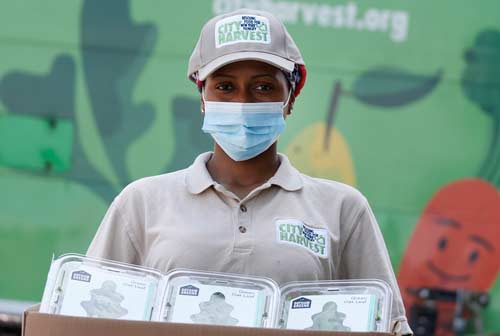Health & Wellness
Some Food Pantries Are Fit for Feasting

by Fai Walker
Over 1.4 million New Yorkers use food pantries to supplement their groceries. Since the advent of Covid-19 that number has increased significantly. Folks who never thought they would ever need a food pantry have needed assistance in providing food for their tables. Food banks, food pantries and you are an essential part of NYC’s food system. Fai Walker tells why.
No one associates feasting with pantries so if this seems a bit of a stretch, I get it. It’s hard to imagine a family who is struggling to put food on the table prepare a feast from food acquired from a food pantry. Because when most of us think about food pantry food we imagine canned and processed foods. Places filled to the brim with food-like substances that contain lots of preservatives, salt, sugar, and chemicals that we cannot pronounce. But I am asking you to imagine something totally different. Imagine a food pantry that not only feeds people but nourishes them with food that helps prevent or avoid diseases that are caused by poor nutrition. Here is a link to food pantries located in Bedford-Stuyvesant and for ways to support your local food pantries. So if you need assistance, don’t be shy, here is a link to where you can get it. https://www.nycfoodpolicy.org/coronavirus-nyc-food-resource-guide-bedford-stuyvesant/
If you are getting provisions from the food pantry here is the skinny: select whole unprocessed foods: fresh fruits and vegetables, dried beans and grains, raw nuts, seeds, eggs, meats, milk alternatives (if you are lactose intolerant) preferably almond, cashew, oat—note: unless soymilk is labelled organic it’s made from genetically engineered soybeans.
Avoid foods with high sugar, salt, or saturated fat content. The Nutrition Facts label on packaged foods and drinks has been updated to make it easier for you to make informed choices. Food labels tell you the number of servings per container, the number of calories per serving, the number of servings in a container, the nutrient amounts (in milligrams or mg) and the percentage of the recommended Daily Value of the nutrient. And if you decide to take canned vegetables and fruits with high sodium or sugar content drain the liquid and rinse the content in a strainer and you will remove more than half of the sugar or sodium content. Check out this link to find out more. Its informative, fun and interactive. https://www.accessdata.fda.gov/scripts/InteractiveNutritionFactsLabel/#intro
Once you understand how to read the labels, here how to calculate the amount of refined sugar in food. The Dietary Guidelines for Americans recommend 6 teaspoons (24grams) for women and 9 teaspoons (36 grams) for men. To calculate the number of teaspoons per serving of sugar divide the grams by four. Don’t be confused, sugar goes by at least 50 other names: high fructose corn syrup, cane sugar or juice, maltose, dextrose, caramel…so sometimes it hard to identify. Sugar is in almost everything including bread, pastries, juices, canned fruits, can and processed foods, sauces, and breakfast cereals. Read the labels before you bag it. Do the math.
Feasting from the food pantry could happen if those of us who are able to donate food are thoughtful about what we donate and intentional about specifying how our dollars should be spent. We could drastically improve the quality of food at our local food pantries and guarantee that our food insecure neighbors can receive nutritious food. Working at a minimum wage job or losing your job should not mean you lose your health.
As a community -prone to high blood pressure, diabetes, heart disease, obesity, and asthma-we can request food pantries use our food dollars to purchase low sodium, low sugar canned foods, purchase more fresh fruits and vegetables and less processed foods and meats. Check out this link for a Healthy Food Donation Checklist https://www1.nyc.gov/assets/doh/downloads/pdf/public/donation-checklist.pdf
OK I get it. But this feast really could happen. In April, Governor Cuomo allocated $25,000,000 for food banks and pantries through a program called Nourish New York. The program supported 3,438 food distributions, providing New York dairy, such as milk, yogurt, cheese, cottage cheese, and fresh produce, meat, seafood, eggs and more to 823,883 households. By October, those funds were exhausted. So, Governor Cumo allocated a second round of funding for $10, 000,000. It is projected that those funds will be exhausted by the end of December.
It’s up to us, whether we are a consumer, a donor or a volunteer to advocate for healthier food options. Some food pantries are already making improvements to their selection of pantry items. BedStuy Rescue MISSION , Bed-Stuy Strong, and Child Development Support Center are excellent models for providing nutritionally sound, culturally relevant food to its community. At these sites, you will find pantries dedicated to providing a foods good enough for feasts that you have only imagined.

